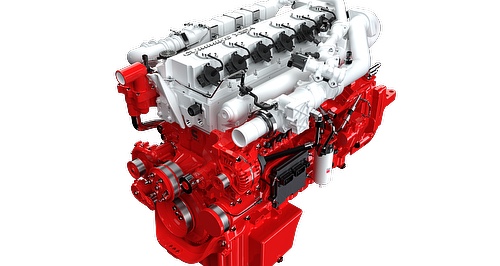Make / Model Search
News - General News - ManufacturingCummins reveals X15H hydrogen engineH 2 GO: The Cummins X15H shares many components with the diesel X15 engine. The engine maker synonymous with diesel power aims to keep on truckin’ with liquid hydrogen27 May 2022 POWER technology giant Cummins has unveiled a 15-litre hydrogen engine that could pave the way for emissions-free heavy transport.
Launched at the Advanced Clean Transport Expo in California, the new powerplant called the X15H is an internal combustion engine that will operate much like a diesel engine but with clean hydrogen fuelling the combustion phase.
It will be built on the company’s new fuel-agnostic engine platform, whose products will share very similar components below the head gasket regardless of their fuel type, with most of the differences occurring above.
The hydrogen version will to go into production in 2027, accompanied by a 6.7-litre version. Cummins hasn’t revealed any output figures but in July 2021 it announced the testing of hydrogen internal combustion engine (ICE) technology, with early results seeing power and torque outputs beyond 213kW and 1100Nm.
According to Cummins, hydrogen internal combustion engines such as the X15H will be more affordable than hydrogen fuel cell electric vehicles (FCEVs) and will be able to be installed in existing-model vehicles with few modifications.
Cummins’ General Manager, Hydrogen Engines Jim Nebergall said they will enable the road-transport industry to take action and reduce greenhouse gas emissions within the decade.
“Our customers are responding favourably to this practical technology. These engines look like engines, they sound like engines, and fit where engines normally fit,” he said.
Cummins isn’t the only engine maker to invest in hydrogen-powered ICE technology. In December 2021, Toyota unveiled a hydrogen-powered version of its GR Yaris featuring the same powertrain as an experimental hydrogen-powered Corolla Sport that was co-developed with Subaru and competed in the Super Taikyu race series in Japan.
The hydrogen GR Yaris concept uses the same fuel tanks and refuelling mechanism as the Toyota Mirai FCEV, with the liquid hydrogen fed to the modified engine that offers better responsiveness than a comparable petrol engine due to diatomic gas’s quicker combustion rate.
Toyota has also teamed up with Yamaha to develop a hydrogen-powered 335kW/540Nm 5.0-litre V8 engine based on the 2UR-GSE donk found under the bonnet of the Lexus RC F.
Meanwhile, Mazda is developing a hydrogen version of its rotary engine.
But there is still some work to go in developing hydrogen ICE engines. While they have benefits over hydrogen FCEV, such as lower costs, end-user familiarity and the ability to be installed in conventional ICE vehicles and even retrofitted, they aren’t as efficient.
When used to fuel an internal combustion engine, hydrogen is only about 30 per cent efficient, which is about the same as petrol. With fuel-cell technology, hydrogen enjoys around 60 per cent efficiency, which means double the range.
And while hydrogen ICE powertrains produce no carbon, the forced induction process produces polluting nitrogen oxide while the only by-product of hydrogen fuel cells is clean water.
But with medium-to-heavy trucks accounting for the most global transport emissions after aviation and shipping, hydrogen engines such as the X15H and their relatively easy integration could see them make a significantly positive impact on the environment, at least in the short term.  Read more |
Click to shareGeneral News articlesResearch General News Motor industry news |












Facebook Twitter Instagram